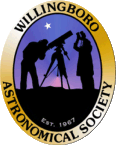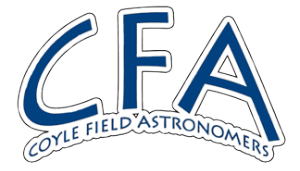Comet C/2014 Q2 (Lovejoy)
December 31, 2014
Comet C/2014 Q2 (Lovejoy) was captured under light-polluted suburban skies (that also included an 84% illuminated moon) from my backyard in Maple Shade, NJ, on December 31, 2014, at 11:14 pm EST. This picture was taken with a Canon EOS 6D digital SLR camera (on a fixed tripod) and a Canon 100 mm f/2.8L macro lens. It is a single exposure of 3.2 seconds at f/4, ISO 3200. The comet, in the constellation Lepus, was at 30° altitude after transiting the meridian at 10:22 pm. The field is about 20° wide x 14° high. Mouseover for labels. Here's a Sky & Telescope article about Lovejoy, which includes some nice finder charts. Click here for a copy of this image labeled with my visual observations from the night of January 1/2, 2015.
Comet C/2014 Q2 (Lovejoy)
December 18, 2014
This view of comet C/2014 Q2 (Lovejoy) was taken from Carranza Field on December 18, 2014, at 12:53 am EST with a Canon EOS 6D digital SLR camera (on a fixed tripod) and a Canon 100 mm f/2.8L macro lens. Exposed 6 seconds at f/4, ISO 6400. The comet, in the constellation Columba, transited the meridian at 12:45 am and so it was near its 12° peak altitude for the night. Mouseover for labels. The field is about 20° wide x 14° high. Lovejoy was initially sighted visually with 10x50 binoculars a couple of hours earlier, on December 17, 2014, at 11:18 pm EST. About a week later, near midnight on December 25, 2014, I was able to spot it naked eye at Coyle Field, a couple of degrees southeast of magnitude 5.3 NuČ Columbae (NuČ was a pinpoint while similarly-bright Lovejoy was slightly fuzzy).
The image below is a 40% crop of the original image (i.e., cropped from the full-size JPEG before size reduction for the web page) to better show the comet itself (now located near the center of the frame). The field is about 8° wide x 5.5° high.
Orion and its Neighbors
October 31, 2014
Taken from Carranza Field on October 31, 2014, at 5:37 am EDT with a Canon EOS 6D digital SLR camera (on a fixed tripod) and a Canon 24 to 105 mm f/4L zoom lens set to 24 mm focal length. Exposed 15 seconds at f/5.6, ISO 6400. Mouseover for labels.
Mercury and the ISS
October 31, 2014
On October 31, 2014, the planet Mercury rose at 5:51 am EDT and this image of it was captured 20 minutes later at 6:11 am when it had reached 3.5° altitude and cleared the distant trees at the eastern corner of Carranza Field in New Jersey's Wharton State Forest (mouseover for labels). Sunrise would be at 7:26 am. The International Space Station (ISS) is the bright streak above-left of Mercury, moving right to left against the background stars of the constellation Virgo. See the table below for a summary of my 2014 Mercury sightings. Taken with a Canon EOS 6D digital SLR camera (on a fixed tripod) and a Canon 100 mm f/2.8L macro lens. Exposed 5 seconds at f/4, ISO 3200.
The picture below looks towards the same corner of the field at 5:33 am EDT, 22 minutes before the start of astronomical twilight. It's a wider field of view extending up into the constellation Leo and shows the Zodiacal Light, as also shown below. Regulus was at 40.5° altitude and Jupiter was at 49.5° altitude (mouseover for labels). Taken with a Canon EOS 6D digital SLR camera (on a fixed tripod) and a Canon 24 to 105 mm f/4L zoom lens set to 24 mm focal length. Exposed 15 seconds at f/5.6, ISO 6400.
Antares Launch... not
October 27, 2014
On October 27, 2014, at 6:45 pm EDT, an Antares rocket with a Cygnus cargo capsule was scheduled to be launched from Wallops Island, Virginia, to the International Space Station. The weather was great, all systems were go, but there was a wayward boat in the hazard zone, so the launch was scrubbed. Here's a picture of our viewing location at the western terminus of Beach Avenue in Cape May, NJ, looking south towards Wallops, 80 miles away. This spot is as far south as one get on land in New Jersey. The bright object in the sky is the greatly overexposed four-day-old crescent moon and the tiny dot of light to its left (above the right-hand side of the clouds) is Mars. The slight hazy patch just above Mars is M8. The constellation Capricornus is in the upper-left corner. Taken at 6:55 pm with a Canon EOS 6D digital SLR camera (on a fixed tripod) and a Canon 24-105 mm f/4L lens set to 24 mm focal length. Exposed 4 seconds at f/4, ISO 1600. They will try again to launch on October 28th at 6:22 pm. Update October 28th: The vehicle exploded a few seconds after liftoff (it wasn't much more than a rocket length above the pad).
The scene below was captured at 7:26 pm EDT, 8 minutes before the end of astronomical twilight. It looks roughly southwest towards Delaware, which is where most of the lights on the horizon are located (there may be a few ships on the horizon too). Again, the crescent moon is greatly overexposed, but now many stars, and even some Milky Way, are visible. The moon is in southeastern Ophiuchus while Mars and M8 are to the left of the moon, and Sagittarius is left of them. A person with a bright LED flashlight is at the end of the rockpile. Same camera, lens and focal length as before. Exposed 4 seconds at f/5.6, ISO 6400.
Zodiacal Light
October 25, 2014
On October 25, 2014, the subtle glow of the Zodiacal Light was observed from Carranza Field in Wharton State Forest, NJ (it was particularly evident with averted vision). The wedge of Zodiacal Light in this picture starts at the tree tops and tapers off as it extends upwards into the zodiacal constellation of Leo. Taken at 5:55 am EDT (six minutes after the start of astronomical twilight) with a Canon EOS 6D digital SLR camera (on a fixed tripod) and a Sigma 14 mm lens, then cropped mildly. It was exposed 8 seconds at f/2.8, ISO 6,400. Jupiter (the brightest object in the picture), Regulus and Rho Leonis are all very close to the ecliptic, so they define a line that more-or-less bisects the Zodiacal Light below them (mouseover for labels).
Mercury will have six elongations in 2014. The initial sighting for each elongation is tabulated below:
|
Sequence |
Initial Sighting Date (2014) |
Observing Location |
Greatest Elongation |
|
#1 |
January 18, 5:41 pm EST | Rt 130 at Creek Rd, Delran, NJ |
January 31, eastern (evening) |
|
#2 |
February 27, 5:56 am EST | RR Tracks, Maple Shade, NJ |
March 14, western (morning) |
|
#3 |
May 6, 8:20 pm EDT | Coyle Field, Woodland Twp, NJ |
May 25, eastern (evening) |
|
#4 |
July 8, 4:53 am EDT | Old Mart Site, Pennsauken, NJ |
July 12, western (morning) |
|
#5 |
August 28, 7:58 pm EDT | Coyle Field, Woodland Twp, NJ |
September 21, eastern (evening) |
|
#6 |
October 25, 6:18 am EDT | Carranza Field, Tabernacle, NJ |
November 1, western (morning) |
The first sighting on January 18 (and the first for 2014) was accomplished with 10x42 binoculars looking through the dirty window of my second-floor office towards an illuminated billboard with Mercury between a couple of parking lot lights. The initial sighting of the second elongation was made on February 27 with 16x70 binoculars and was aided by an earthshine-filled crescent moon, about 45 hr before new, 5.5° away. The initial sighting of the third elongation was made on May 6 with 10x42 binoculars (then seen with unaided eyes) by marking the position of the setting sun. The initial sighting of the fourth elongation was made on July 8 with 16x70 binoculars by dropping 9° from brilliant Venus (it was then seen with 10x42 binoculars, but not with unaided eyes). The initial sighting of the fifth elongation was made on August 28 with 16x70 binoculars, pinpointing the area along the horizon with the compass in my iPhone 5s (it was also seen with 10x42 binoculars at 8:10 pm, but not with unaided eyes). The initial sighting of the sixth elongation was made on October 25 with 10x42 binoculars through tree tops (6.5° directly below Porrima), then sighted immediately with unaided eyes. The next greatest elongation will be on January 14, 2015 following superior conjunction on December 8, 2014, so there's a chance of starting next year's cycle at the end of December 2014.
The current sighting streak is now 25 elongations in a row, starting in January 2011, which makes four complete years (click here for previous sightings). The purpose of continuing this streak is not to set some sort of record (especially since I have no idea what sort of record might exist), but to demonstrate that locating and seeing Mercury is not nearly as difficult as many suppose. It just takes a little planning and effort.
Click here for some older images.



